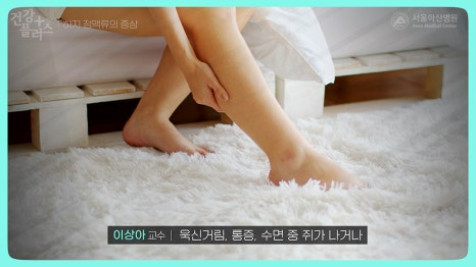Heavy, Aching Legs? Watch Out for Varicose Veins!

Heavy, Aching Legs?
Watch Out for Varicose Veins!
Hello, I'm Lee Sang-ah from the Department of Vascular Surgery at Asan Medical Center in Seoul, and I specialize in the surgical treatment of vascular diseases. Today, I'd like to discuss the causes, symptoms, and treatment of varicose veins.
Causes of Varicose Veins
Varicose veins occur when the valves in the veins are damaged, causing blood to flow backward instead of in the correct direction. Let me explain the valves in more detail. Arterial blood flows easily from the heart to the legs due to the heart's pumping action and gravity. However, venous blood must travel from the feet back to the heart, against gravity, without a pump like the heart. The blood flow is propelled upwards only by the contraction of the calf muscles squeezing the veins. Therefore, veins in the legs have valves that prevent blood from flowing backward, ensuring it flows only upwards towards the heart. When these valves are damaged due to various reasons, blood flows backward towards the feet.
The causes of valve damage are diverse. However, the most common cause is prolonged standing without calf muscle contraction or sitting for extended periods while working, which impairs valve function. Standing for long periods increases the pressure inside the veins, causing them to widen. As the veins widen, the valves can no longer close properly, leading to backflow. This backflow further increases venous pressure, further impairing valve function, creating a vicious cycle that results in the development of varicose veins.
Typical Symptoms of Varicose Veins
Varicose veins have several characteristic symptoms. Because a lot of blood pools in the leg veins, the legs may feel heavy. Other symptoms include aching, pain, nighttime leg cramps, and itching around the varicose veins. These symptoms vary from person to person and are not necessarily related to the degree of vein protrusion or backflow. Some people with severely protruding veins may have no symptoms, while others with minimal protrusion may experience a heavy sensation in their legs. Severe varicose veins caused by venous reflux can lead to skin problems such as recurrent eczema, pigmentation, and venous ulcers, so caution is needed.
Edema is also a very common symptom. However, leg edema has many causes, so not all edema indicates varicose veins. Leg edema can also occur in the elderly due to reduced calf muscle mass from decreased activity, or it can be caused by surgery or radiation therapy in the abdominal or pelvic area. In addition, hypothyroidism, heart failure, kidney dysfunction, and some high blood pressure medications can also cause edema. Therefore, if leg edema persists for a long time in middle-aged or older adults, it is advisable to check for the aforementioned conditions.
Treatment and Management Based on Progression
In the early stages, if pain or edema is not severe and does not significantly interfere with daily life, it is acceptable to wear compression stockings and monitor the condition. Although there is significant individual variation, generally, if the veins are only slightly protruding, it may take about 10 years to progress to the next stage. Therefore, if there is little discomfort and no major cosmetic concerns, there is no need to rush into surgery.
However, if skin symptoms such as eczema, pigmentation, or ulcers are present, immediate treatment is necessary. Without treatment, the skin lesions will worsen and improve repeatedly, eventually deteriorating. If surgical treatment is deemed necessary, an ultrasound examination will be performed to identify which veins have backflow. The superficial veins in the legs include the great saphenous vein and the small saphenous vein, which are the main sources of backflow. Once the refluxing vein is identified, surgery is performed to remove or block it.
Removing or blocking the refluxing vein does not cause problems because there are bypassing normal veins and deep veins. Recently, treatments that block the vein using laser or radiofrequency ablation are primarily recommended rather than stripping the vein. There is also a treatment method that involves injecting medical adhesive into the vein. However, patients who need to have protruding veins removed may require incisions in the skin where the veins are located to extract the enlarged vessels one by one, which may leave surgical scars depending on the condition.
Preventing Varicose Veins
As mentioned earlier, varicose vein surgery is not always necessary if symptoms are not severe. Conservative treatments such as wearing compression stockings and performing walking exercises that use the calf muscles can improve symptoms. The same applies to prevention. Even if you do not currently have varicose veins, wearing compression stockings and taking short walks whenever possible during work hours can be helpful. Also, elevating the calf area above the heart during sleep to allow blood to flow upwards can be beneficial.
- Professor Lee Sang-ah, Department of Vascular Surgery, Asan Medical Center -
















Source :https://blog.naver.com/amc_seoul/223865041045
No comments yet.
